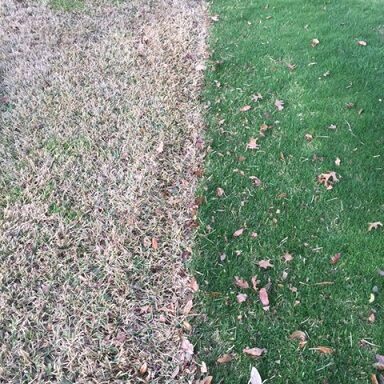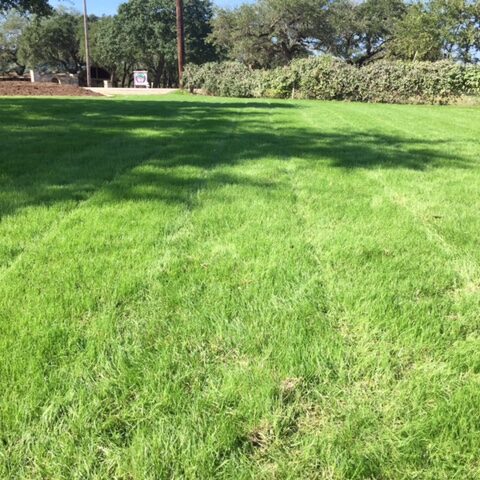Winter rye grass (or ryegrass) is the perfect way to keep your lawn green through the winter in Austin. It also keeps your lawn healthy and strong by preventing new weed growth.
We "overseed" perennial rye grass over your existing lawn in the fall. We use a hydraulic slit seeder, and always recommend getting your lawn aerated and top-dressed at the same time.


A bit of info on turf grass
Lawn types vary throughout the country, with different types of grass used as turf grass in various parts of the country. Turf grasses are selected to fit each location’s needs, but the primary factor that determines what type of turf grass will grow is weather. Grass types are split into two broad categories, Warm-Season grasses and Cool-Season grasses.
Austin is definitely a region where Warm-Season grasses thrive. Our long hot summers and mild winters are perfect for Bermuda, St. Augustine and Zoysia lawns. Our grasses are green and growing three seasons out of four, and typically go dormant in the winter. Winter over-seeding is used to bridge the gap, resulting in a year-round lawn.
Winter over-seeding is possible because our winter months have perfect weather for Cool-season turf grass. We get too hot in the summer for cool-season grasses to live long, so it is impossible to establish a perennial winter lawn. But if we use a good, fast growing grass it is possible to grow a temporary lawn that looks amazing.
Winter Rye
The grass type most commonly used in over-seeding is rye grass. Rye is a very fast-growing grass that is easily established. It doesn’t take long for rye to grow from seed to healthy lawn. Rye is a clumping grass type, and only forms a turf when seeded thickly. There are a lot of varieties of rye, and it can be an annual or perennial grass type. Perennial rye is intended to be a permanent turf grass in colder areas, and annual rye is a temporary seasonal grass used for a variety of purposes.
Annual rye is used almost everywhere, in both cold and warm climates. Annual rye will live for a season, and then die. It is used as a cover crop to keep weeds out of fallow fields, as a companion seed to help cool-season lawns get established, and as a southern winter grass. If you see a random bag of winter rye in the store, it is most likely a variety of annual rye.
Perennial rye is very similar to annual rye, except it can survive year after year in a cooler climate. Perennial rye is first and foremost a turf grass, and has been grown and developed for only that one purpose. As a result, it is tends to have a finer blade, better color, and a soft foot-friendly texture.
Rye is very easy to grow and maintain. It is a lot easier to keep a rye lawn green in the winter than keep a Bermuda or St. Augustine lawn green in an Austin summer. Mother nature typically provides most of the water needed after the lawn gets going. The cooler weather means a smaller amount of water goes along way.
Biggest Benefit of a Winter Lawn
The largest, and most obvious reason people over-seed with rye is to have a green useable lawn year-round.
One of the advantages of living so far south is that we have mild winters. Most winter days are warm enough that you can still enjoy the outdoors. Our winter lawns are actually usable, not just decorative. With winter rye the kids or grandkids actually have a lawn to play on over the Christmas break. Even if you prefer to hang out on your porch with a cup of coco, having a green lawn greet you instead of a dormant stretch of brown is always nice.
Additional Benefits of a Winter Lawn
Beyond simply having a green lawn there are several very good reasons to over-seed. The first is that it helps eliminate winter weeds, it helps improve the soil, and shelters and protects your existing lawn.
Winter weeds can be a problem in colder climates. Most of the herbicides used to control weeds in lawns can’t be applied when the temperature falls below a certain level. This limits weed control to preventative pre-emergent herbicides applied in the fall, or old fashioned hand pulling. Without a healthy, growing lawn, winter weeds can grow unhindered. Having rye helps quite a bit.
The rye grows vigorously enough that it can out compete most weeds. If the rye is healthy, it will completely choke out some of the most common and pesky winter lawn weeds.
As an added benefit, the rye makes a good “green manure.” Green manures are plants used to add nutrients to the soil. Some plants add nutrient directly to the soil, but others work by adding organic matter that decomposes into nutrients. Rye falls into the second category.
When used as a cover crop in agriculture, the rye grass is plowed directly into the soil, adding nutrients that will be used by the next crop. On lawns, the grass clippings are mulched back into the lawn, with the grass plant itself dying and decomposing into the soil in the spring. Rye is high in nitrogen, one of the vital nutrients Bermuda lawns needs to stay green through the heat of the summer.
The last benefit of rye is that it shelters your existing lawn. In cool-season lawns, rye seed is added to seed mixes because it grows up quickly sheltering the young new lawn, and then dies out after the lawn grows in strong. Up north, the shelters the grass from heat, down here it shelters the lawn from cold.
Our warm-season lawns are not very cold hardy. Sudden shifts in temperature at the wrong times can cause extensive damage to both Bermuda and St. Augustine lawns (though Zoysia is more tolerant of cold.) Soil temperature will fluctuate more with exposed soil than with soil insulated from the cold air. Mulch provides insulation to keep your plants alive in the planting beds. Rye can fill that role in a lawn. And the rye actually likes the cold!
What we do
We use a special machine called a hydraulic slit seeder to over-seed lawns. This is very different from broadcast spreading most people are familiar with. Our seeder distributes the correct amount of seed directly into the soil of the lawn. Using the slit seeder limits accidental seeds in planting beds. Because the seed is put in direct contact with the soil, it is easier to get the seed to germinate. The seed is evenly distributed so there are rarely bare spots or thin spots – both problems are common with broadcast seeding.
The hydraulic slit seeder has the added benefit of loosening and dethatching the top of the lawn. The blades that push the seed into the soil are very similar to the blades of a dethatching machine, and have a similar result. If there is excessive dead grass in your lawn it will be removed.
What makes us different?
As far as we know, we are the only company to use a hydraulic slit seeder to over-seed lawns. We looked, and couldn’t find anyone offering a similar service. In fact, we had to special order our machine. I don’t know why we are the only ones using it, but it works great!
We also only use perennial rye grass. It is more expensive, but the results are much better than using an annual rye. Perennial rye will still die in our hot weather every spring, but the lawn it produces over the winter is thick, green, and lush.
Basically, we decided that if we were going to offer winter rye, we should only offer the best winter rye, seeded the best possible way.
A few Warnings about Winter Rye:
Rye grass is grown from seed, so it is incompatible with pre-emergent herbicides. Pre-emergent herbicides work by preventing seeds from germinating. Our method of slit seeding will disturb the soil enough that the grass seed should still germinate even with a pre-emergent treatment. But it is best to simply consider these two services incompatible. The good new is that rye is generally more effective than pre-emergent applications anyways.
Another thing to avoid is weed-and-feed fertilizes from big box stores. They shouldn’t be used very often anyways, but the herbicides in these products are harmful to new grass and germinating grass seed.
Last few thoughts
The only real downside to having a lawn all winter is that is needs to be maintained in the winter. Fortunately, maintaining a winter lawn isn’t terribly hard. You can mow the grass short, or let it grow long. Generally, it’s a good idea to keep your winter lawn a little longer than you keep your summer lawn. Our mow crews can handle the mowing for you, so that shouldn’t be a big inconvenience.
You do need to give a newly seeded lawn extra water to get it going. It’s best to keep the grass seed damp until it grows up into a healthy lawn. After it grows, water can be cut back to more minimal levels. Thankfully, we usually get enough rain over the winter that irrigation is only needed when the sky fails to provide enough moisture.
The best way to get your winter lawn to grow in is by having your lawn top dressed at the same time as the over-seeding. These two services work well together, and result in not only a good winter lawn, but a healthier summer lawn as well.
Get Winter Rye Overseeding with Top Choice!
Simply provide your address and some other basic information to receive a fast free quote from the lawncare specialists at Top Choice Lawn Care.

